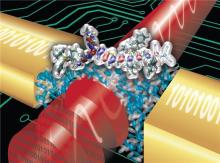The cover of the Journal of Materials Chemistry C features the new organic electro-optical (OEO) chromophore BTP7 which was developed by researchers using a theory-guided design methodology pioneered by the Robinson and Dalton groups at the UW.
The team — comprised of Postdoctoral Scholar Huajun Xu, Research Scientists Lewis Johnson, Delwin Elder, and Scott Hammond, Professors Bruce Robinson and Larry Dalton, and partners at KU Leuven and Nonlinear Materials Corporation (NLM) — used theory-aided design to greatly improve the hyperpolarizability (molecular-level nonlinear optical performance) of organic chromophores without overwhelming stability or absorbance issues, reflecting the first set of a new generation of engineered chromophores targeting optical networking and computing applications.
The researchers’ predictions of BTP7’s outstanding hyperpolarizability were tested by researchers at KU Leuven whose measurements show it has over 3x the static hyperpolarizability of JRD1.
The paper, “Bis(4-dialkylaminophenyl)heteroarylamino donor chromophores exhibiting exceptional hyperpolarizabilities,” published on February 8, 2021, describes the highest molecular-level response of any OEO material on record.
When used at a 10% concentration within an inert polymer such as PMMA (plexiglass), BTP7 matches the electro-optical activity performance of classic OEO material JRD1 at 100% concentration and delivers 12x the performance of JRD1 for a given mass of material. However, BTP7’s performance does not increase with added concentration. The high performance at low concentration makes the chromophore well-suited for blending with a variety of polymers or applications where a low refractive index is desired. The team has been utilizing discoveries from this project to develop chromophores with similar hyperpolarizabilities but even larger bulk performance.
NLM is a spinout company from the Department of Chemistry and has commercialized OEO materials from the Dalton and Robinson groups including JRD1 and HLD and has others in the pipeline. In addition to their academic and staff appointments at the UW, Johnson is the Chief Scientific Officer, Elder is the Director of Materials Development, Hammond is the Director of Process Development, and Robinson is the Senior Advisor at NLM. NLM has licensed a portfolio of patents and patent applications from UW CoMotion, and continues to be in active collaboration with the UW to develop and commercialize these technologies.
